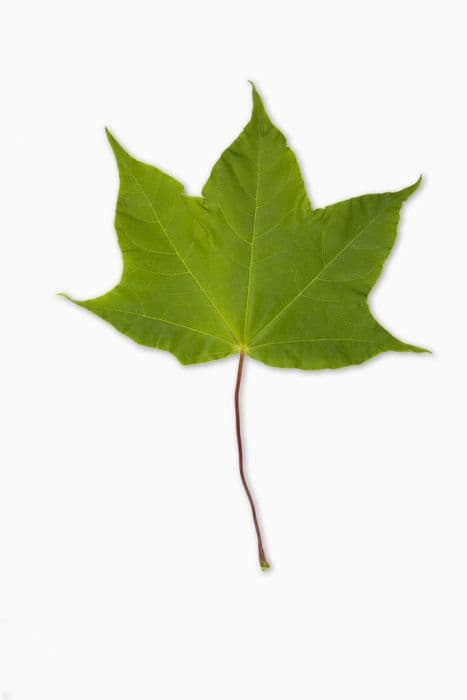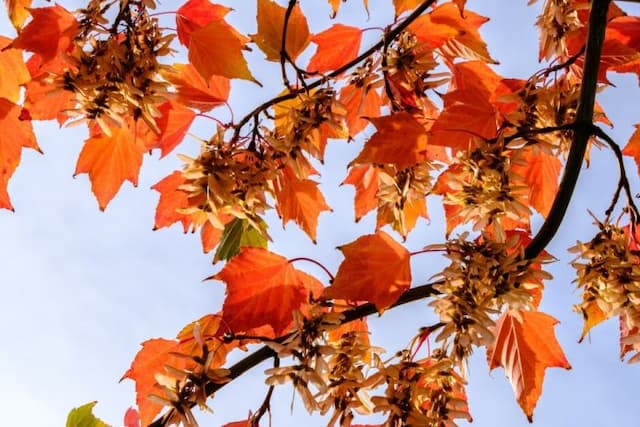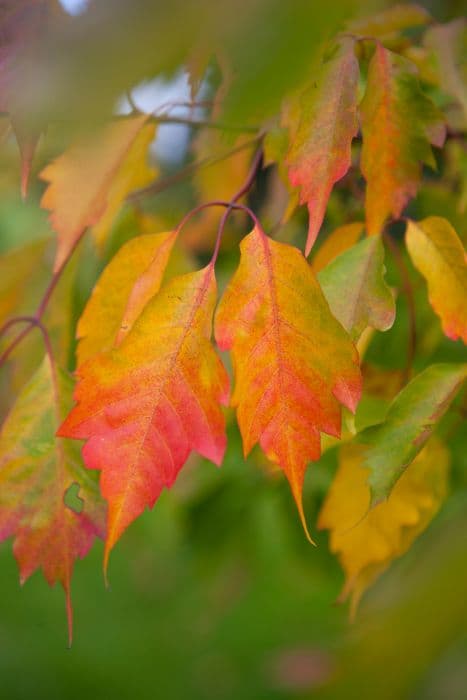Japanese Maple Acer palmatum 'Crimson Queen' (D)

ABOUT
Acer palmatum 'Crimson Queen' is a Japanese maple cultivar admired for its beautiful and distinctive appearance. This plant features a cascading form with branches that spread outwards giving it a delicate, weeping habit. The leaves of 'Crimson Queen' are finely dissected, meaning they have a lace-like quality with deeply cut, narrow lobes that create a feathery look. The foliage showcases a rich crimson color, offering a vivid display that persists throughout the growing season. In spring, the leaves emerge with a bright red hue that can have undertones of purple. As the season progresses into summer, the leaves may deepen into a more burgundy tone, showcasing various shades of red that add depth and complexity to the plant's overall visual appeal. In autumn, 'Crimson Queen' provides a final show with leaves that can transition to vibrant shades of scarlet, bringing a warm burst of color to the landscape. The combination of the plant's architectural form and its changing leaf colors through the seasons makes it a standout specimen in any garden setting, often used for its aesthetic appeal and ability to create focal points. Beyond its colorful foliage, 'Crimson Queen' may also produce small red flowers that subtly complement the leaves in spring. The flowers can give way to winged seed structures known as samaras, which have a characteristic shape and can add an additional layer of interest to the plant's appearance. These seeds can hang from the branches, adding texture and movement to the display. Overall, Acer palmatum 'Crimson Queen' is celebrated for its cascading shape, intricate leaf structure, and dynamic color range, which together create a stunning visual impact in any space where plant size is not the primary consideration.
About this plant
 Names
NamesFamily
Aceraceae
Synonyms
Crimson Queen Japanese Maple, Red Laceleaf Japanese Maple, Cutleaf Japanese Red Maple
Common names
Acer palmatum var. dissectum 'Crimson Queen', Acer palmatum 'Dissectum Atropurpureum', Acer palmatum 'Dissectum Rubrum'
 Toxicity
ToxicityTo humans
Japanese maple, including the 'Crimson Queen' cultivar, is not considered toxic to humans. There are no well-documented cases of poisoning from ingesting parts of the Japanese maple tree, so it is generally considered safe around humans with regard to toxicity.
To pets
Japanese maple, specifically the 'Crimson Queen' variety, is not known to be toxic to pets such as dogs and cats. There have been no significant reports of poisoning in pets after ingesting parts of this plant, so it is generally not a cause for concern with regards to pet toxicity.
 Characteristics
CharacteristicsLife cycle
Perennials
Foliage type
Deciduous
Color of leaves
Red
Height
8 feet (2.4 meters)
Spread
10 feet (3 meters)
Plant type
Tree
Hardiness zones
5-9
Native area
Japan
Benefits
 General Benefits
General Benefits- Ornamental Value: The 'Crimson Queen' Japanese maple is known for its attractive foliage and cascading form, making it a standout feature in any garden or landscape design.
- Seasonal Interest: This variety offers year-round interest with its striking red foliage that turns even more vibrant in the fall, providing a captivating display.
- Shade Tolerance: It can grow well in partial shade, offering flexibility in garden placement and providing a solution for darker areas of the garden.
- Compact Size: With its moderate growth habit and smaller stature, 'Crimson Queen' is suitable for smaller gardens or spaces where a full-sized tree would be impractical.
- Low Maintenance: Japanese maples require relatively low maintenance compared to other ornamental trees, needing only occasional pruning to maintain their shape.
- Attracts Wildlife: The tree can attract birds and butterflies, adding to the biodiversity of the garden whilst also providing natural beauty.
- Drought Resistance: Once established, it is relatively drought-tolerant, making it suitable for gardens in drier climates, although it does prefer consistent moisture.
- Erosion Control: The root system can help stabilize the soil on slopes, making 'Crimson Queen' a practical choice for erosion-prone areas.
 Medical Properties
Medical PropertiesThis plant is not used for medical purposes.
 Air-purifying Qualities
Air-purifying QualitiesThis plant is not specifically known for air purifying qualities.
 Other Uses
Other Uses- Photography Backdrop: The 'Crimson Queen' Japanese maple, with its distinctive red foliage, can be used as a stunning natural backdrop for portrait and wildlife photography.
- Seasonal Decorations: Leaves from the Japanese maple can be dried and used in fall wreaths and centerpieces to add natural and vibrant red color to home decor.
- Culinary Presentation: In upscale culinary presentations, the small, delicate leaves of the Japanese maple can be used as ornate garnishes for plating.
- Artistic Inspiration: The color and structure of Japanese maple trees can inspire artists and be used as a live model for paintings and drawings.
- Theme Gardens: Japanese maples can be used to create a theme for gardens, such as a Zen garden or a red-themed garden for a stunning visual impact.
- Bonsai Culture: With its natural tendency towards intricate branch structure and elegance, the 'Crimson Queen' makes an excellent candidate for the art of bonsai.
- Craft Materials: Slender branches and twigs from pruning can be repurposed into handcrafted items, such as miniature trellises or plant supports for other garden plants.
- Natural Shading: Planted in strategic locations, the dense foliage of the Japanese maple can provide delicate shade to shade-loving plants or small garden nooks.
- Leaf Castings: The unique shape of the leaves can be used to make decorative concrete or plaster leaf castings that can be used as garden ornaments or wall hangings.
- Education: The tree can be used as a teaching tool for horticulture students to learn about different leaf types, tree shapes, and the cultural requirements of ornamental trees.
Interesting Facts
 Feng Shui
Feng ShuiThe Japanese Maple is not used in Feng Shui practice.
 Zodiac Sign Compitability
Zodiac Sign CompitabilityThe Japanese Maple is not used in astrology practice.
 Plant Symbolism
Plant Symbolism- Beauty: Acer palmatum 'Crimson Queen', commonly known as the Japanese Maple, is highly valued for its aesthetic appeal. Its intricate foliage and stunning seasonal colors symbolize the beauty in nature.
- Peace: The serene growth habit and gentle shape of the Japanese Maple's leaves and branches often represent peace and calmness, ideal for contemplative gardens.
- Balance: The symmetric canopy and harmonious growth pattern of the Japanese Maple convey a sense of balance, often used in traditional Japanese gardens which prioritize equilibrium.
- Endurance: As a plant that experiences and withstands the changing of seasons, the Japanese Maple symbolizes endurance and the ability to survive adversities.
- Grace: The delicate leaves and the soft, weeping form of this cultivar in particular, showcase grace and elegance, making it a symbol for these qualities.
 Water
WaterJapanese maples, like the 'Crimson Queen', should be watered deeply when the top couple of inches of soil feel dry to the touch, typically once or twice a week, depending on weather conditions. It’s important to water the plant slowly, allowing the water to soak into the soil to reach the deeper roots. Generally, during the growing season in the absence of rainfall, you might need to provide about 10 gallons per week for a young tree, adjusting for size, weather, and soil conditions. In the winter, reduce watering since the plant will be dormant and the water demand will decrease significantly.
 Light
LightThe 'Crimson Queen' Japanese maple thrives in a spot with partial shade to full sun, ideally receiving morning sunlight and afternoon shade. This light pattern helps to protect the foliage from the harshest midday sun which can sometimes scorch the delicate leaves, especially during the hot summer months. Consistent, gentle light will help maintain the vibrant red color of the leaves throughout the growing season.
 Temperature
TemperatureThe 'Crimson Queen' Japanese maple does well in a range of temperatures but prefers a climate where temperatures hover between 60°F and 80°F. It's hardy in USDA zones 5 through 8, tolerating minimum winter temperatures as low as -20°F. Extreme heat above 90°F can stress the plant, especially if accompanied by direct sunlight and drought, so providing some shade and moisture during peak summer heat can help.
 Pruning
PruningPruning the 'Crimson Queen' Japanese maple should be done to maintain its natural weeping shape, remove any dead or diseased wood, and to improve air circulation within the canopy. The best time for pruning is in late fall or winter when the tree is dormant. Light pruning can be done annually, but major shaping should be done less frequently, only as needed to maintain the desired form.
 Cleaning
CleaningAs needed
 Soil
SoilThe best soil mix for the Japanese Maple 'Crimson Queen' is well-draining soil with a mixture of peat, pine bark, and perlite or coarse sand. The ideal soil pH should range from slightly acidic to neutral, about 5.5 to 7.0.
 Repotting
RepottingJapanese Maple 'Crimson Queen' should be repotted every 2-3 years to ensure it has enough room for growth and to replenish nutrients in the soil.
 Humidity & Misting
Humidity & MistingJapanese Maple 'Crimson Queen' prefers moderate humidity levels but is relatively adaptable to the humidity levels typically found outdoors.
 Suitable locations
Suitable locationsIndoor
Grow in bright, indirect light with room to branch out.
Outdoor
Place in dappled shade, shelter from strong winds.
Hardiness zone
5-8 USDA
 Life cycle
Life cycleThe life cycle of the Crimson Queen Japanese maple begins with seed germination in optimal conditions of warmth and moisture, where the embryo within the seed sprouts and begins to form the root and shoot system. Following germination, the seedling goes through a juvenile phase, characterized by rapid growth and the formation of a basic woody structure and foliage, including its distinctive red-colored, lace-like leaves. As the tree enters maturity, it develops into a small, dome-shaped ornamental with increased foliage density and begins the reproductive phase, producing small purple flowers that are somewhat inconspicuous compared to the foliage. After pollination, these flowers give way to samaras, the characteristic winged fruits of maples, which disperse by wind to propagate the species. The Crimson Queen Japanese maple experiences a yearly cycle of growth in spring and summer, followed by a sensational autumn display where leaves turn vibrant shades of red and purple before falling. Finally, the tree enters a period of dormancy in winter, conserving energy to repeat the growth cycle in the coming spring.
 Propogation
PropogationPropogation time
Late winter-early spring
The Japanese Maple 'Crimson Queen' is typically propagated through grafting, the most popular method for this particular variety. This process usually takes place during the dormant season, which is late winter to early spring. Grafting involves taking a piece of stem with leaf buds from the 'Crimson Queen' and joining it onto the rootstock of another maple that is hardy and possesses a strong root system. The scion, which is the part taken from the 'Crimson Queen', is carefully attached to a slit made in the rootstock. It's then bound tightly and sealed with grafting wax to prevent dehydration and disease while the graft heals. This method has a high success rate and replicates the desirable characteristics of the 'Crimson Queen' such as its weeping habit and rich crimson foliage.









